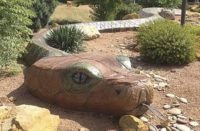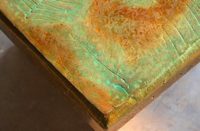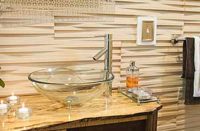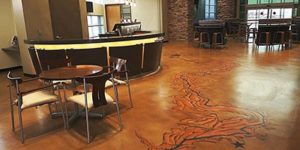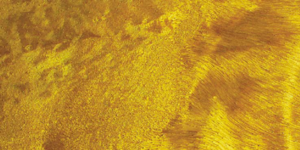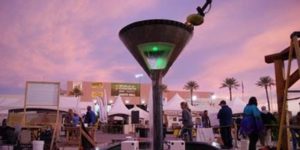|
|
Steve VandeWater, 51, was a Fine Arts major at Indiana University Bloomington, studying sculpture, drawing and printmaking. This artistic background informs his approach to concrete and also gives him skill and success with different styles and techniques. “The art background is where a lot of my inspiration and ability comes from,” he says.
Fresh out of college, VandeWater started pouring concrete on a municipal crew, and the work suited him. “I liked it because it was fast-paced and you saw immediate results. I don’t have a lot of patience!” he jokes. “I’ve been in concrete ever since.”
One day in the early 1990s, VandeWater happened to drop by the job site of a local Bomanite installer who appeared to be short-handed. “I asked him if he needed help and he said yes,” says VandeWater, “so I stayed and helped him finish and watched how he did the stamping.” At that time in Indiana, stamped concrete was almost unknown, and there were no local suppliers of materials. The Bomanite contractor shared his tips on where to get the supplies that a stamper would need.
Not long after, VandeWater quit his regular concrete job and started his own independent company, ArtistiCrete LLC, doing nothing but stamping, staining, stenciling and concrete countertops, using the best products he could find from a variety of sources. Initially, much of his work came from residential customers who wanted their patios torn out and replaced. “They had a gray concrete patio and wanted something fancier, so they would hire me to tear it out and replace it with something stamped,” recalls VandeWater. “Patios and small residential work were the majority of my business.”
In the late 1990s, in addition to contracting, VandeWater opened and operated a small decorative concrete supply business. At that time, however, there were so few local customers that he sold the supply business and returned to contracting full time. “In retrospect, I should have stuck it out. Decorative concrete soon became a booming business in Indianapolis.”
Despite the harsh winter weather in Indiana, the decorative concrete industry took hold there and grew quickly. “I don’t know why it became so popular here, but the growth of the Internet at that time certainly helped bring decorative concrete to a much wider audience. It was new and unique,” recalls VandeWater. “The time had simply come for it. When people started seeing it in magazines or on the Internet, they wanted it.” By the mid-2000s, several more decorative concrete supply stores had opened in Indiana, so the materials were readily available and many more contractors began learning to install decorative concrete.
VandeWater’s mold-making skills from college served him well over the years, and he was able to make many of his own stamps, skins and texture rollers. For the Artistry in Decorative Concrete demos at World of Concrete 2012, he created a stamp that mimicked a broken mosaic tile texture. Atop the tile texture, he stained a picture so that his completed work resembled an ancient Greek mosaic. For the 2014 demos, he designed a texture skin of layered coins.
When VandeWater was actively installing his own work, he created a number of projects that showcased his skill in varied mediums. A short-lived sports bar in Indianapolis hired him to make countertops that looked like basketballs, footballs and baseballs. For a residential wine cellar floor, VandeWater drew a design depicting grapes and a cask, and he painted it freehand with acid stains. For a homeowner, VandeWater drew a sun with a face and sunglasses, etched it into the concrete with a grinder and then stained it. “Drawing is what I really like to do,” he says.
VandeWater’s molded textures are very unique and have become one of his signatures. Although he doesn’t generally sell these textures, he could. “I’ve had Butterfield Color cast the molds for me with the understanding that if anybody wanted them, they would be free to sell to them.”
Moving into sales
In 2011, after contracting for 18 years, VandeWater closed ArtistiCrete and took a full-time job running The Concrete Store at Sagamore Ready Mix in Fishers, Indiana. Closing his contracting business was partly a response to a dramatic increase in local competition.”
There were so many new contractors getting into the business,” he explains, “that there was an overabundance of them. Contractors were selling their work so cheaply that it was harder to make a good living. I was working far more hours than I ever had and not making as much money doing it.”
VandeWater and his business partner were actually doing the installations themselves, and it was taking its toll on their bodies. “As we got older, we realized that there had to be easier ways to make a living.” For now, he plans to stay on the supply and education side of the industry.
With a full-time sales job, VandeWater doesn’t get to spend as much time on his own creative projects as he would like, but when he does, he has fun with it. Hence, a hand-carved Mayan calendar and an actual working concrete mandolin. Part of the appeal for him is trying to create something that no one else has ever done before.
With a full-time sales job, VandeWater doesn’t get to spend as much time on his own creative projects as he would like, but when he does, he has fun with it.He used fiberglass reinforcing and a proprietary concrete mixture to make it somewhat flexible.
To make the mandolin, VandeWater built a form, covered it with the reinforced material, demolded it and used acid stains to color it. The inspiration for how to build the strong yet lightweight mandolin came from speaking with Mark Whitten of Iowa-based Earth Medium, who created the eagle atop Adrian Gascon’s Artistry exhibit at the 2014 World of Concrete. “Whitten’s individually made feathers were my big inspiration,” says VandeWater.
“What I like about decorative concrete is that you’re basically taking a plain gray material and making it resemble something else, and you’re working under pressure,” he says. “You attempt to make it look as realistic as possible during a very short window, because you have to do your thing before the concrete gets too hard to work.”
At Sagamore Ready Mix, VandeWater runs The Concrete Store, trains contractors and troubleshoots. He often goes out onto job sites where contractors are experiencing some kind of problem that they don’t know how to solve, and he assesses the situation and brainstorms with the contractor.
Education and the future
In 2013 VandeWater became the decorative concrete columnist for Concrete Surfaces magazine. A website that he created, INdecorativeconcrete.com, has become a unique hub of information for decorative concrete professionals and homeowners alike. “I wanted a clearinghouse of information, especially as it pertains to Indiana customers, including such things as how the local climate can affect concrete,” VandeWater says. “I wanted a place where contractors could be showcased, potential customers could hook up with them, and there would be a lot of information for anyone. I wanted to provide comprehensive information about decorative concrete in general.” VandeWater’s website offers troubleshooting tips, fixes and prevention techniques, all based on real-world experience. “The articles on the site deal with issues that I ran into over and over in my years of contracting,” he says. “So instead of telling people about it individually I created the website to reach a larger audience.”
VandeWater sees an unlimited future for the decorative concrete professional. “There is so much more that can be done if someone is innovative,” he says. “The surface is barely being scratched and there are a lot of creative people involved in driving the industry, not only contractors but artists and people with all sorts of great ideas. There are some very interesting products and methods being introduced every day.”
www.indecorativeconcrete.com
